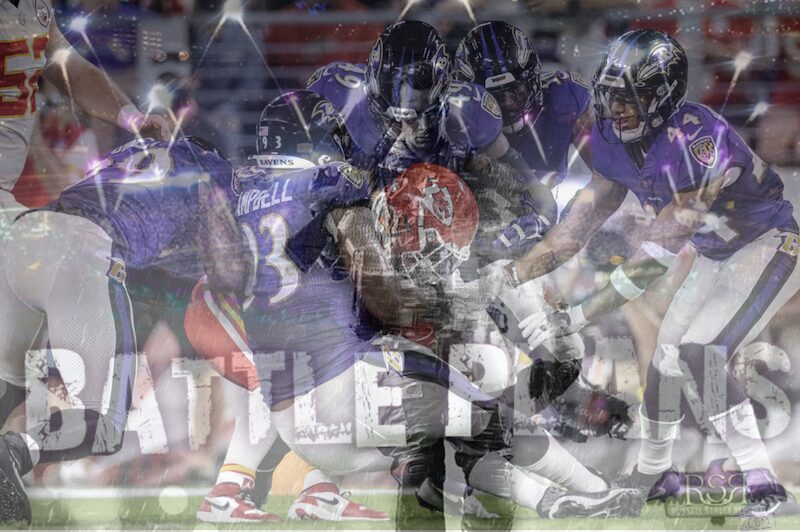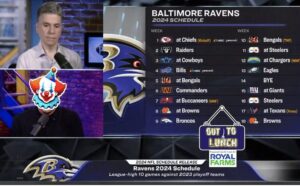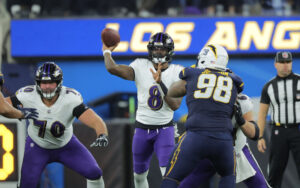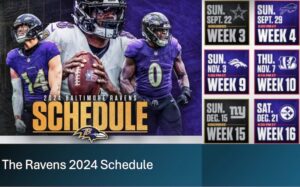RSR’s Dev Panchwagh & Nikhil Mehta are tag-teaming Battle Plans for the 2023-24 season.
Defense
Layered Rush: The 2024 Edition
Whether the Ravens were going to face Josh Allen or Patrick Mahomes in the AFC Championship, devising a way to contain either QB when they start to move out of the pocket was always going to be a necessity.
With Mahomes over Allen, the danger of the run is a little less pronounced. Allen runs at a high frequency in the way the Bills use him. Mahomes really isn’t that type of runner, & never has been.
However, his ability to use his legs to buy time and open up the scramble drill for his receivers is well documented. So much so that the last time the Ravens faced Mahomes, in 2021, then defensive coordinator Don “Wink” Martindale came up with a layered rush just for the Kansas City passer.
The layered rush is sort of an offshoot of a spy approach, except it involves more than one defender keeping an eye on Mahomes when he moves. The goal is to wait to rush Mahomes until he starts to break contain. Until then, you’re basically rushing three and four, trying to keep him within the rush lanes.
Once he breaks, then it’s on those second level defenders to move with him without totally abandoning their back end responsibilities.
Will the layered rush reappear in the title game? It wouldn’t be surprising if Mike Macdonald takes a page from Wink’s book. The benefit of this scheme is that you essentially keep Mahomes in a bubble and he can’t pinpoint who the spy really is.
Whether it’s use of delayed blitz or this form of a layered rush, the objective has to be to keep Mahomes from improvising too often outside of the pocket, much as it is for Lamar Jackson on the other side of the ball.
The Ravens should have plenty of opportunities to get after Mahomes. The Chiefs’ 7.6% pass rate over expected is the highest in the NFL and Mahomes’ 2.78-second time to throw is 9th-highest, but his 15% pressure to sack rate (2nd-lowest) has led to an overall sack rate of just 4.0% (also 2nd-lowest).
In essence, getting pressure isn’t enough. Blitzes have to be designed not just to hurry or contain Mahomes, but to disrupt his throws and get him on the ground.
Limit the Yards After Catch
The Kansas City offense has evolved under head coach Andy Reid. They went from a downfield aerial attack featuring the indefensible Tyreek Hill, with an emphasis on vertical routes and the speed game, to more of a control passing game that relies on their receivers to break tackles in space.
The latter approach is more aligned to Reid’s West Coast offense sensibilities. Get the ball out on time (three- and five-step drops), in stride and turn pass catchers into runners in space. If it’s 3rd and 10, the receiver could conceivably gain those yards instead of catching the ball at the sticks.
This shows up in an extreme way in the Chiefs’ statistics. Their 6.51 average depth of target is second-lowest, while their 6.32 yards after catch per reception is second-highest. Reid’s understanding of spacing and route design allows him to deploy concepts that move defenders out of position downfield to set up YAC potential for underneath routes.
This modified attack is also designed to help Mahomes. He doesn’t have to hold the ball as long as he used to, and his accuracy on anticipation throws is among the best in the league. The Chiefs run a lot of combinations involving deeper routes to clear space underneath for their receivers and tight ends (see: Travis Kelce) to gain yards in the open. They also get the ball out to their outlets, even Isiah Pacheco, as a way to keep the offense on track and to augment their ground game.
Along with route spacing, they are also a good screen team, just like they’ve always been under Reid. The Texans came awfully close to hitting on screens last week, but the Ravens have been tough to crack for the most part all season, especially with the pterodactyl-like wingspan of Kyle Hamilton bearing down on receivers catching screens.
The Chiefs also run a lot of curl routes – the most popular route for Kelce, Rashee Rice, Justin Watson and Marquez Valdes-Scantling – requiring the Ravens to take smart angles and wrap up pass-catchers instead of trying to go around their bodies to make a play on the ball. That’s how missed tackles and YAC can start to rack up.
The defense will need to slow down the passing game: hitting the receivers at the line, making sure there aren’t clear releases. And they will need to rally to the ball in a big way. We’ve seen that ability all year. The Chiefs will stress those angles and discipline about as much as any offense they’ve faced all season.
Anticipating Mismatch Opportunities
Reid is about as good as any play caller in NFL history. Like any elite play caller and play designer, his ability to exploit matchups and attack certain formations is second to none.
Reid will do this through pre-snap motion (4th highest rate in the NFL), misdirection (which will also set up their running game), and different personnel groups. For instance, against Buffalo, the Chiefs operated from more 3-TE looks and attacked the Bills’ linebackers in the passing game. That switch to heavier personnel aligns with a season-long Chiefs trend: efficiency with multiple tight ends on the field. Two tight ends is by far their most efficient personnel grouping, with a 0.06 EPA/play out of 12 personnel at a usage rate of 27.5%.
Macdonald’s ability to match wits with Reid, in particular when it comes to formation/personnel chess moves, will be a monumental key within this larger key. Perhaps one of the advantages he has is that he might not even have to substitute his personnel group much, if at all, to avoid total predictability.
That’s key against Kelce’s freedom within the Chiefs’ offense, which is particularly dangerous with multiple tight ends on the field. He and Mahomes use motion and option routes to isolate an ill-equipped defender – either a too-slow linebacker or too-small cornerback – to set up easy mismatches for big gains.
The Chiefs averaged 1.80 TEs per play vs the Bills. Some of that comes from the extra TEs come from 13 personnel, but they run a lot of 12.
For that personnel group, Hamilton at SCB is a great tonic.
It's was noted by @ASchatzNFL that base has been more effective than nickel…
— Ken McKusick (@FilmstudyRavens) January 24, 2024
Baltimore could feasibly stay in their base nickel or even base defense altogether and have the power and athleticism to match up equally against Reid’s heavier packages. Maybe that means bringing an extra safety on the field (Geno Stone) so Hamilton can drop in the box to play as a linebacker. If the Chiefs’ tight ends are able serve a dual role, it will be important that Macdonald can match up without having to go too light, which he has been known to do to prioritize defending the pass.
Offense
Navigating Spags’ Blitz and Rush Frenzy
The Ravens have Macdonald – the master of disaster. But his counterpart on the other sideline, defensive coordinator Steve Spagnuolo, might be among his inspirations as a play caller.
“Spags,” as many call him, has perfected the art of the blitz in a unique way over the years. Not only is he an aggressive play caller, but he is pulling from threads as far back as the secondary. Corners are fair game to blitz. Expected the unexpected. And he marries that approach with a lot of man/press man coverage because he is totally confident in his secondary to win.
The Chiefs’ usage rate (7.8%) and EPA/play allowed (-0.54) when they bring six or more pass rushers both rank in the top 10, but their pressure rate of 37.9% and sack rate of 6.7% rank 20th and 23rd, respectively. That means they are forcing the ball out of the opposing quarterback’s hand and forcing incompletions or completions for short gains. Those aggressive blitzes set up the Chiefs’ success with just four pass rushers, which they deploy just 65.7% of the time (seventh-lowest in the NFL), with a -0.06 EPA/play allowed (seventh-best), 28.9% pressure rate (fifth-best) and 8.2% sack rate (best). Like Macdonald, Spags likes to run simulated pressures that show blitz with players dropping into coverage off the line of scrimmage. For this matchup – arguably one of the toughest of even his storied career – he’ll likely take things to another level with defensive backs blitzing from depth and plays designed to limit Lamar Jackson’s scrambling lanes.
Along with this all-hands-on-deck attack strategy, he also exploits teams up front by moving his ends and tackles around to improve their matchups. Remember, Spags is the guy who created the “NASCAR package” when he was the DC with the Giants. He will line up a tackle like Chris Jones at defensive end, especially in high leverage 3rd down situations, when he truly needs the pass rush to win. In fact, Jones hit Allen last week on a key incompletion in the red zone that could have been a touchdown otherwise.
Jackson should be pretty familiar with Spags’ play-calling tendencies since has faced him plenty of times. And if he needs a refresher, the Texans gave him a lot of the same treatment with their pressure packages – combining DB blitzes with stunts/line games, to create clear rush lanes.
Jackson and offensive coordinator Todd Monken did a nice job of adjusting to the blitz heavy attack in the second half.
More early down passes where the ball was out quick. Passes to the perimeter and the use of backs, especially Justice Hill, on hots and quick hitters. In the case of Hill, he was used once on a nifty jerk route where he went into motion on a free release, then cut in and then out, to gain yards on a chunk play to beat the blitz.
It will take more of those types of plays and tactics to defeat Kansas City’s scheme. To help neutralize their complexity, it’s also imperative for the Jackson and Monken brain trust to stay in more third-and-manageable situations altogether. It keeps Spags from his bag of tricks.
Running from Shotgun
The Chiefs are a decidedly worse defense against the run than the pass, allowing the third-lowest EPA/pass at -0.10 and the third-highest EPA/rush at 0.00. Meanwhile, the Ravens’ 0.04 EPA/rush and 156.5 rush yards per game both lead the NFL and their 4.9 yards per carry ranks third.
That’s a clear avenue of attack for the Ravens, who rumbled for 229 yards on the ground in their Divisional Round victory over Houston. Jackson led the way with 100 yards on a combination of scrambled and designed QB runs, while Hill averaged over 5.0 yards per carry, mostly out of the shotgun.
That combination will be the key to success on the ground against the Chiefs, who have allowed 5.13 yards per carry and recorded the lowest stuff rate in the NFL against shotgun.
The Baltimore Ravens have the second-most runs out of shotgun this season (343 carries) and are averaging 5.56 yards per carry.
The Chiefs are allowing 5.13 yards per carry and have the lowest stuff rate in the league against runs out of shotgun.
— Connor Allen (@ConnorAllenNFL) January 23, 2024
Meanwhile, the Ravens have the second-most runs out of shotgun in the league, averaging 5.56 yards per carry when they do so. Baltimore has found success all year spreading defenses out with 11 personnel and attacking the open space on the ground, but they’ve been far more efficient out of heavier formations, with 0.16 EPA/play out of 21 personnel and 0.20 EPA/play out of 12 personnel.
That’s because Baltimore’s heavy personnel groupings are so versatile across all elements of the rushing and passing offense.
First, there’s Patrick Ricard, who serves as lead blocker (and chief mauler) in the run game and a 6th offensive lineman in pass protection – when he’s kept in to block on passing plays, a notable adjustment in the second half vs. Houston. But since he’s a fullback, not a lineman, he can frequently go in motion to give the offense a numbers advantage, uncover information about the defense, or serve as a decoy.
Patrick Ricard said "got it guys, you go have fun." https://t.co/ncaZmngMIi pic.twitter.com/cK54UQRcAT
— Nate Tice (@Nate_Tice) January 23, 2024
Then, there’s Isaiah Likely (and Mark Andrews, who is anticipated to go), who can be inline or split out to the slot, giving the Ravens an advantage in the run and pass game no matter where they line up. Likely’s touchdown vs. the Texans is an example of the hybrid threat the offense can bring out of heavy formations. Jackson did a great job tucking the ball to sell the run-fake, while Likely slipped behind the defense into a 1-on-1 matchup that he promptly won, having gotten on the same page with his QB from an earlier mishap.
Part 2: Lamar puts it up for likely.
6.
The end. pic.twitter.com/5SIbC8puRA
— Cole Jackson (@ColeJacksonFB) January 22, 2024
If the Ravens can run effectively out of shotgun, they can be at their most multiple and dangerous, fully utilizing Jackson’s dual-threat abilities to get the most out of the rest of their offensive weapons.
Attacking from Heavy and Staying Aggressive on Early Downs
The Ravens’ 10th-ranked 0.6% pass rate over expected may not seem like much, but it’s the first time in Jackson’s career that Baltimore’s PROE has been positive. That has come with an increased willingness to throw the ball on early downs, where the Ravens have found success to the tune of a seventh-ranked 0.12 EPA/pass. Their 0.00 EPA/rush on early downs still ranks second, but passing on early downs helps the Ravens stay ahead of the sticks and opens up their playbook on later downs. That’s reflected in their late-down efficiency, which jumps to 0.16 EPA/pass and an even-more impressive 0.27 EPA/rush.
With the expectation of heavy pressure packages from the Chiefs’ D, the Ravens should establish a rhythm in their passing games on early downs using quick passes into space, with a healthy dose of screens and RPOs. (The Chiefs will probably be expecting some screens, since the Ravens put plenty on film this season, so Monken should also have a fake screen/shot play in his back pocket as a second-half counterpunch.)
Rolling out heavy personnel on early downs and forcing the Chiefs to match in base personnel will open up opportunities to attack KC’s linebackers in coverage. The status of LB Willie Gay will be key to the Chiefs’ middle-of-field pass defense, as there’s a significant drop off from him to Drue Tranquill and Nick Bolton.

The Ravens should be working the middle of the field no matter what, but Gay’s absence could really let them open the floodgates, especially if Likely and Andrews can get on the field at the same time. The Chiefs’ heavy deployment of Cover 1 and Cover 2 coverage looks will also be susceptible to some of the deep overs that the Ravens were able to hit during the regular season for big gains.
Staying aggressive and picking up chunk yardage on early downs will help the Ravens dictate the flow of their offense and avoid 3rd-and-long situations where Spagnuolo can roll out his best blitz packages. Then, Baltimore’s ability to convert first downs on the ground on late downs will allow them to keep drives moving and open up the potential for explosive plays down the field as the game goes on.
One-on-One Matchup
Kyle Hamilton vs. Travis Kelce
Everyone called it. Everyone knows this is the marquee matchup of this game. And even Hamilton himself confirmed that he will be part of a team approach to defend Kelce. No surprise there. Hamilton has etched his place as one of the best overall defenders in the league. His 4.2 yards allowed per target is the best of any safety in the NextGenStats era, but you can’t even reduce him to one position.
Hamilton Island 🏝️@kyledhamilton_ pic.twitter.com/LvomP6UwjB
— NFL GameDay (@NFLGameDay) January 24, 2024
But he is so much more than a defined safety. He’s a versatile chess piece who can be an impact defender against the run or pass from a variety of alignments. As a slot defender especially, he is quite literally shattering the mold, leading the NFL with just 0.45 yards per slot coverage nap allowed this season.
Travis Kelce: 49.4% of passing snaps from the slot this season
Kyle Hamilton: 0.45 yards per slot coverage snap allowed this season (1st)
— PFF BAL Ravens (@PFF_Ravens) January 24, 2024
The interesting part is that Kelce could be defined in a similar way. He’s not a tight end, really. He’s a receiver who the Chiefs move around all over the field to exploit matchups, especially into the slot where he gets a whopping 49.4% of his receiving snaps and 50.4% of his targets.
Meanwhile, Hamilton’s 424 slot defense snaps for 42.8% of his 2023 defensive snap count, and his 279 slot coverage snaps lead NFL safeties this year, so he and Kelce will battle out of the slot throughout the game.
Kelce’s propensity to move around the Chiefs’ offense to draw mismatches may keep him away from Hamilton at times, and the young safety may not always follow him. Hamilton’s specific word choice was interesting – it will likely take more than one defender to handle Kelce. Furthermore, Mike Macdonald prefers to dictate to opposing offenses, deploying his defensive playmakers as disruptive weapons regardless of what the other team’s plans are. He won’t want to reduce Hamilton’s multifaceted ability to affect a game to shadowing Kelce, even if he is Mahomes’ top target.
The two will meet, though. It will be almost inevitable, in some of the biggest moments of the game, for both sides to go best-on-best and match up Kelce and Hamilton in the slot – on third downs and in the red zone especially. When that happens, there will be a true power struggle for the middle of the field.
This will be a critical battle for the whole game. Hamilton is going up against his most difficult test to date. He will need to be fluid with his movements, anticipate Kelce’s double moves, and play a physical game, especially when it comes the release off the line.
All advanced stats courtesy of Sumer Sports and Pro Football Focus unless otherwise noted.












One Response
Outstanding article. So much sports coverage is just fluff. This is meat and potatoes. Thank you.